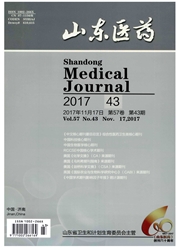

 中文摘要:
中文摘要:
目的:评估针对不稳定半月板撕裂,关节镜下半月板部分切除术(APM)是否优于单纯理疗。方法:纳入36例经磁共振确诊为不稳定半月板撕裂的患者,平均年龄35岁,其中9例伴轻度骨关节炎。所有患者于前8周,每周行3次物理治疗,包括股四头肌功能锻炼和神经一肌肉功能锻炼。完成康复训练后1周行关节镜下半月板部分切除术。在治疗前、理疗结束后以及术后第4周随访时行VAS评分进行疼痛评估并行Lysholm评分进行功能评估。结果:36例患者的VAS评分由治疗前的5.66±1.10,改善为理疗结束后的4.39±0.95(P〈0.05),行APM术后则达到1.82±0.77(P〈0.05),并且理疗对VAS的改善不如APM明显(P〈0.05)。治疗前,伴骨关节炎患者的疼痛症状更为明显,而APM术后则与不伴骨关节炎的患者无明显差异(P〉0.05)。患者Lysholm评分理疗结束后由58.11±8.06提高到62.11±8.34(P〈0.05),APM术后则达到86.78±5.50(P〈0.05)。相对于骨关节炎患者,不伴骨关节炎患者的Lysholm评分更高(P〈0.05)。结论:物理治疗能有效减轻疼痛和肿胀症状,但是对关节活动受限等改善不明显。APM相对于理疗能有效缓解症状,改善膝关节功能。
 英文摘要:
英文摘要:
Objective: To evaluate whether arthroscopic partial meniscectomy (APM) was superior to physical therapy in the treat- ment of unstable meniscal tears. Methods: A total of 36 patients were diagnosed with unstable meniscal tears by clinical examination and magnetic resonance imaging (MRI). Age ranged from 19 to 50 years (average 35.08). Mild osteoarthritis was diagnosed in 9 cases. Physi- cal therapy was offered 3 times per week for the first 8 weeks, including faradic quadriceps stimulation and neuromuscular strengthening exercises. After physical therapy, patients were treated by APM. Outcomes were evaluated by the VAS score and the Lysholm score. Results: Mean VAS before interventions was 5.66±1.10, signiftcantly improved to 4.39± 0.95 after physical therapy and to 1.82 after APM (P 〈0.05). Before intervention, patients with osteoarthritis suffered more pain than those without osteoarthritis. Furthermore, patients with osteoarthritis had similar VAS score with those without osteoarthritis after APM (P 〉0.05). Mean Lysholm score before physical therapy was 58.11± 8.06, significantly improved to62.11± 8.34 after physical therapy and to 86.78±5.50 after APM (P〈0.05). Howev- er, patients without osteoarthritis had higher Lysholm scores than those with osteoarthritis after APM (P〈0.05). Conclusions: Physical therapy could effectively relieve pain and swelling, but not significantly on improving joint fimctions. APM could exert better effects on relieving joint symptoms or improving joint functions than that of physical therapy.
 同期刊论文项目
同期刊论文项目
 同项目期刊论文
同项目期刊论文
 期刊信息
期刊信息
